Aviation Merit Badge
Aviation Merit Badge. Aviation MB Requirements. Do the following: Define "aircraft." Describe some kinds and uses of aircraft today. Explain the operation of piston, turboprop, and jet engines. Point out on a model airplane the forces that act on an airplane in flight.
Share Presentation
Embed Code
Link
Download Presentation
- aircraft
- control surfaces
- pilot certificates
- safety rules
- private pilot certificates
- terminal radar control facility

lisawoods + Follow
Download Presentation
Aviation Merit Badge
An Image/Link below is provided (as is) to download presentation Download Policy: Content on the Website is provided to you AS IS for your information and personal use and may not be sold / licensed / shared on other websites without getting consent from its author. Content is provided to you AS IS for your information and personal use only. Download presentation by click this link. While downloading, if for some reason you are not able to download a presentation, the publisher may have deleted the file from their server. During download, if you can't get a presentation, the file might be deleted by the publisher.
Presentation Transcript
- Aviation Merit Badge
- Aviation MB Requirements • Do the following: • Define "aircraft." Describe some kinds and uses of aircraft today. Explain the operation of piston, turboprop, and jet engines. • Point out on a model airplane the forces that act on an airplane in flight. • Explain how an airfoil generates lift, how the primary control surfaces (ailerons, elevators, and rudder) affect the airplane's attitude, and how a propeller produces thrust. • Demonstrate how the control surfaces of an airplane are used for takeoff, straight climb, level turn, climbing turn, descending turn, straight descent, and landing. • Explain the following: the sport pilot, the recreational pilot and the private pilot certificates; the instrument rating.
- Aviation MB Requirements • Do TWO of the following: • Take a flight in an aircraft, with your parent's permission. Record the date, place, type of aircraft, and duration of flight, and report on your impressions of the flight. • Under supervision, perform a preflight inspection of a light airplane. • Obtain and learn how to read an aeronautical chart. Measure a true course on the chart. Correct it for magnetic variation, compass deviation, and wind drift to determine a compass heading. • Using one of many flight simulator software packages available for computers. "fly" the course and heading you established in requirement 2c or another course you have plotted. • Explain the purposes and functions of the various instruments found in a typical single-engine aircraft: attitude indicator, heading indicator, altimeter, airspeed indicator, turn and bank indicator, vertical speed indicator, compass, navigation (GPS and VOR) and communication radios, tachometer, oil pressure gauge, and oil temperature gauge. • Create an original poster of an aircraft instrument panel. Include and identify the instruments and radios discussed in requirement 2e.
- Aviation MB Requirements • Do ONE of the following: • a. Build and fly a fuel-driven or battery powered electric model airplane. Describe safety rules for building and flying model airplanes Tell safety rules for use of glue, paint, dope, plastics, fuel, and battery pack. • b. Build a model FPG-9. Get others in your troop or patrol to make their own model, then organize a competition to test the precision of flight and landing of the models.
- Aviation MB Requirements • Do ONE of the following: • Visit an airport. After the visit, report on how the facilities are used, how runways are numbered, and how runways are determined to be "active." • Visit a Federal Aviation Administration facility control tower, terminal radar control facility, air route traffic control center, or Flight Standards District Office. (Phone directory listings are under U.S. Government Offices, Transportation Department, Federal Aviation Administration. Call in advance.) Report on the operation and your impressions of the facility. • Visit an aviation museum or attend an air show. Report on your impressions of the museum or show.
- Aviation MB Requirements • Find out about three career opportunities in aviation. Pick one and find out the education, training, and experience required for this profession. Discuss this with your counselor, and explain why this profession might interest you.
- Requirement 1a • a. Define "aircraft." Describe some kinds and uses of aircraft today. Explain the operation of piston, turboprop, and jet engines.
- What Is An Aircraft • An aircraft is a vehicle that can fly by being supported by the air • Two main types are lighter than air vehicles and heavier than air vehicles • Aircraft can also be powered and un-powered • Aircraft can also be manned or un-manned
- Requirement 1b • b. Point out on a model airplane the forces that act on an airplane in flight.
- Forces on an Airplane Flight is the result of the balance of these forces
- How is Lift Created?
- Lighter Than Air Aircraft Lift is created by hot air or gases less dense than air.
- Heavier Than Air Aircraft Wings Produce Lift
- Requirement 1c • c. Explain how an airfoil generates lift, how the primary control surfaces (ailerons, elevators, and rudder) affect the airplane's attitude, and how a propeller produces thrust.
- How Do Wings Produce Lift Bernoulli’s Principle
- How is Thrust Created?
- Un-Powered Aircraft No Thrust
- Powered Aircraft Thrust is Created By the Powerplant
- Types of Powerplants • Piston Prop Engines • Similar to a car engine • Thrust is produced by propeller
- Types of Powerplants • Jet Engines • Thrust is produced by jet exhaust
- Types of Powerplants • Turboprop Engines • Mix of propeller and jet engine • Thrust is produced mostly by propeller
- How is Drag Created? Caused by Flow Over Surfaces
- How are Aircraft Controlled?
- Forces Acting on Aircraft LIFT THRUST DRAG WEIGHT (gravity)
- How an Airfoil Works ? • Bernoulli’s Principle
- How Do Control Surfaces Work ?
- Directional Control • YAW - rudders • PITCH - elevators • ROLL - ailerons
- YAW • Rudder – The foot pedals are connected by means of wires or hydraulics to the rudder of the tail section. The rudder is the vertical part of the tail that can move from side to side.
- ROLL • Ailerons – The stick is connected by means of wires or hydraulics to the wings’ ailerons. By turning the stick, the pilot can change the positions of the ailerons.
- PITCH • Elevators – The stick (joy stick) is connected by means of wires or hydraulics to the tail section’s elevators. By moving the stick, the pilot can change the position of the elevators.
- Requirement 1d • d. Demonstrate how the control surfaces of an airplane are used for takeoff, straight climb, level turn, climbing turn, descending turn, straight descent, and landing.
- Takeoff & Climb
- Landing
- Requirement 1e • e. Explain the following: the sport pilot, the recreational pilot and the private pilot certificates; the instrument rating.
- Types of Pilot Certificates • Sport • Cannot carry more than one passenger, authorized to fly only light-sport aircraft during the daytime only • Recreational • May fly aircraft of up to 180 horsepower (130 kW) and 4 seats in the daytime for pleasure only • Private • May fly for pleasure or personal business. Private pilots cannot be paid, compensated to fly, or hired by any operator. • Instrument Rating • An add-on to the private pilot certificate that allows the pilot to fly in limited visibility conditions
- Requirement 2 • Do TWO of the following: • Take a flight in an aircraft, with your parent's permission. Record the date, place, type of aircraft, and duration of flight, and report on your impressions of the flight. • Under supervision, perform a preflight inspection of a light airplane. • Obtain and learn how to read an aeronautical chart. Measure a true course on the chart. Correct it for magnetic variation, compass deviation, and wind drift to determine a compass heading. • Using one of many flight simulator software packages available for computers. "fly" the course and heading you established in requirement 2c or another course you have plotted. • Explain the purposes and functions of the various instruments found in a typical single-engine aircraft: attitude indicator, heading indicator, altimeter, airspeed indicator, turn and bank indicator, vertical speed indicator, compass, navigation (GPS and VOR) and communication radios, tachometer, oil pressure gauge, and oil temperature gauge. • Create an original poster of an aircraft instrument panel. Include and identify the instruments and radios discussed in requirement 2e.
- Instruments
- Instruments
- b. Build a model FPG-9. Get others in your troop or patrol to make their own model, then organize a competition to test the precision of flight and landing of the models.
- Model FPG-9 • See handout for template and instructions.
- Requirement 4 • Do ONE of the following: • Visit an airport. After the visit, report on how the facilities are used, how runways are numbered, and how runways are determined to be "active." • Visit a Federal Aviation Administration facility control tower, terminal radar control facility, air route traffic control center, or Flight Standards District Office. (Phone directory listings are under U.S. Government Offices, Transportation Department, Federal Aviation Administration. Call in advance.) Report on the operation and your impressions of the facility. • Visit an aviation museum or attend an air show. Report on your impressions of the museum or show.
- Requirement 5 • Find out about three career opportunities in aviation. Pick one and find out the education, training, and experience required for this profession. Discuss this with your counselor, and explain why this profession might interest you.
- Job Opportunities • Careers with the Airlines • Landing Facilities • Engineering Research & Development • General Aviation • Government Aviation • Aerospace Industries • Military Aerospace (USAF, USN, USMC, USA, NOAA) • National Aeronautics & Space Administration (NASA)
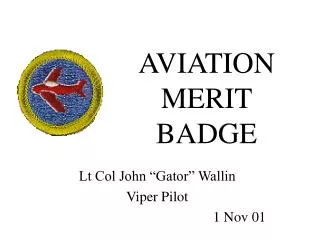
AVIATION MERIT BADGE
AVIATION MERIT BADGE. Lt Col John “Gator” Wallin Viper Pilot 1 Nov 01. I Want to Be a Pilot
1.22k views • 29 slides

Forestry Merit Badge
What is Forestry?. The science, art, and practice of managing and using trees, forests, and their associated resources for human benefit.. What is a Forest?. Land with a tree canopy that covers at least 10 percent of the area.Lands that have been harvested or recently replanted but are not dedicated to another land use..
6.69k views • 96 slides

Photography Merit Badge
Requirements:. Explain how the following elements and terms affect the quality of a picture: a. Light-natural light/ambient, flash b. Exposure-aperture (f-stops), shutter speed, depth of field c. Composition-rule of thirds, leading lines, framing, depth d. Angle of view e. Stopping action 2.Explain the basic parts and operation of a film camera or digital camera. Explain how an exposure is made when you take a picture.
3.05k views • 50 slides
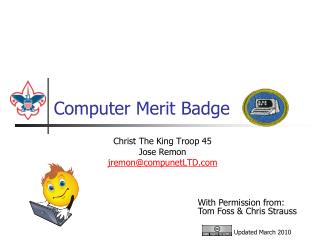
Computer Merit Badge
Computer Merit Badge. Christ The King Troop 45 Jose Remon jremon@compunetLTD.com. With Permission from: Tom Foss & Chris Strauss. Updated March 2010. Requirements. Discuss with your counselor the tips for online safety.
1.5k views • 62 slides

Chess Merit Badge
Chess Merit Badge. Chess History: An Ancient & Popular Strategy Game. by Joseph L. Bell with a lot of material from Dr. John McCrary. © 2011. History of Chess. Origin in India as “Chaturanga” Spread to Persia, Middle East, & Europe Changes to piece moves in Europe
1.56k views • 31 slides
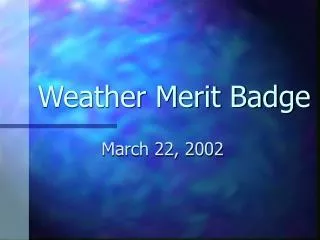
Weather Merit Badge
Weather Merit Badge. March 22, 2002. Requirements. Define meteorology. Explain how the weather affects farmers, sailors, aviators, and the outdoors construction industry. Tell why weather forecasts are important to each of these groups.
3.71k views • 25 slides
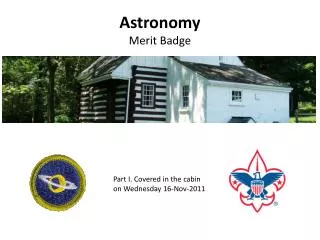
Astronomy Merit Badge
Astronomy Merit Badge. Part I. Covered in the cabin on Wednesday 16-Nov-2011. Review. Counselor Name: Niels Ryde E-mail ryde@comcast.net We covered requirements 1 – 3 and 4 in part.
1.22k views • 31 slides

EAA Boy Scout Aviation Merit Badge Program Classroom
EAA Boy Scout Aviation Merit Badge Program Classroom. FLIGHT FORCES. Aviation Merit Badge Program - Classroom Forces of Flight( WORKBOOK )____________ FOUR FORCES of FLIGHT LIFT, GRAVITY, THRUST, DRAG
210 views • 0 slides
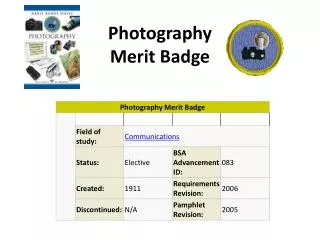
Photography Merit Badge
Photography Merit Badge. Photography Merit Badge.
648 views • 33 slides
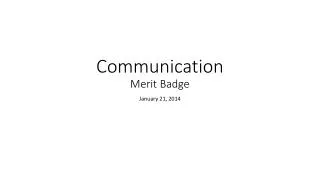
Communication Merit Badge
Communication Merit Badge. January 21, 2014. Communication: A Key to Opening Doors. Why is communication important in your life? Good communication includes: Expressing yourself Listening carefully to others Knowing when to speak up Knowing when to keep your thoughts to yourself.
5.16k views • 29 slides

Geocaching Merit Badge
Geocaching Merit Badge. The Plan for Today. What is Geocaching? Safety How to Find a Geocache Mapping: GPS, UTM, Compass How to Hide a Geocache Geocaching Terms CITO Leave no Trace Geocaching Game. What is Geocaching?.
3.19k views • 48 slides
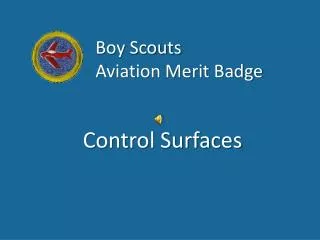
Boy Scouts Aviation Merit Badge
Boy Scouts Aviation Merit Badge. Control Surfaces. Primary Control Surfaces. Rudder. Ailerons. Elevator. Aileron. The ailerons are located near the rear end of the wing tip. Aileron. controls the roll of the plane. Longitudinal axis. Elevators.
741 views • 17 slides
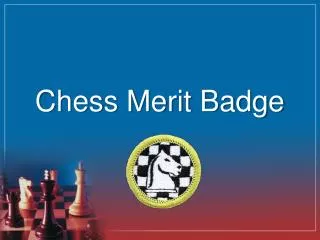
Chess Merit Badge
Chess Merit Badge. History of the Game of Chess. The history of chess spans some 1500 years. The earliest predecessors of the game originated in India, before the 6th century AD.
2.55k views • 105 slides
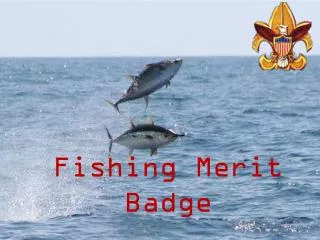
Fishing Merit Badge
Fishing Merit Badge. Fishing Safety. First Aid - Hook Removal. Know Your Equipment. Fly Rod. Baitcasting Rod. Spinning Rod. Trolling Rod. Bait & Lures. Improved Clinch Knot. Palomar Knot. Double Surgeons Loop Knot. Blood (Barrel) Knot. Dropper Loop Knot. Scout Codes of Ethics.
3.29k views • 19 slides

Computer Merit Badge
Computer Merit Badge. Merit Badge College 9 Feb 2008. Requirement 1 - Online safety. Requirement 1 – Discuss with your counselor the tips for online safety. Requirement 1 - Online safety. . Kidnapping/Violence Safety.
711 views • 37 slides

Aviation Merit Badge
Aviation Merit Badge. Navigation, Instruments, and Getting a Pilot ’ s License. Maps. A map is “ A representation, usually on a plane surface, of all or part of the earth or some other body showing a group of features in terms of their relative size and position ”
942 views • 24 slides

Photography Merit Badge
Photography Merit Badge. Here’s what we’re gonna talk about……. * A brief History of Photography * Camera Types * Essentials of a Photo * Parts of a camera * Digital vs Film Cameras * Telling a story with Photos * Photography Careers * Final MB Requirement assignment. PHOTOGRAPHY
1.49k views • 34 slides
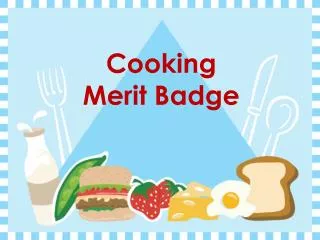
Cooking Merit Badge
Cooking Merit Badge. Requirements. 1. Do the following: a. Review with your counselor the injuries that might arise from cooking, including burns and scalds, and the proper treatment. b. Describe how meat, fish, chicken, eggs, dairy products, and fresh
2.91k views • 66 slides

Astronomy Merit Badge
Astronomy Merit Badge.
6.02k views • 127 slides





















